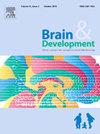TANGO2缺乏症的肌肉和甲状腺表现:一个新的双等位基因变异的案例研究
IF 1.3
4区 医学
Q4 CLINICAL NEUROLOGY
引用次数: 0
摘要
tango2缺乏症(TDD)是一种罕见的常染色体隐性遗传病,可引起复发性代谢危象,其特征为脑病、横纹肌溶解、致命性心律失常和甲状腺功能减退等。然而,肌肉磁共振成像(MRI)和甲状腺功能在TDD中的临床过程尚未得到很好的描述。患者为3岁男童,无相关病史。在表现出偶发性共济失调后,他出现了两次代谢危象,最终被诊断为TDD的新变体。在临床过程中,MRI显示下肢肌肉迁移信号改变,在两次横纹肌溶解时主要影响腓肠肌、比目鱼肌、股二头肌和股内侧肌。此外,患者经历了甲状腺功能异常与原发性甲状腺功能减退模式,自发解决。结论本病例对TDD的肌肉MRI表现和甲状腺功能异常有新的临床认识,有助于TDD的早期诊断和治疗。本文章由计算机程序翻译,如有差异,请以英文原文为准。
Muscle and thyroid manifestations in TANGO2 deficiency disorder: a case study of novel biallelic variants
Introduction
TANGO2 deficiency disorder (TDD) is a rare autosomal recessive disease that causes recurrent metabolic crises characterized by encephalopathy, rhabdomyolysis, fatal arrhythmia, and hypothyroidism, among others. However, the clinical course of muscle magnetic resonance imaging (MRI) and thyroid function in TDD have not been well described.
Case presentation
The patient was a 3-year-old boy with no relevant medical history. After showing episodic ataxia, he developed metabolic crises twice and was eventually diagnosed with TDD with a novel variant. During the clinical course, MRI showed migratory signal changes in the lower limb muscles, primarily affecting the gastrocnemius, soleus, biceps femoris, and vastus medialis during the two episodes of rhabdomyolysis. Furthermore, the patient experienced a thyroid function abnormality with a primary hypothyroidism pattern that resolved spontaneously.
Conclusion
The case findings provide novel clinical insights into muscle MRI findings and thyroid function abnormalities in TDD and can help in early diagnosis and management of TDD.
求助全文
通过发布文献求助,成功后即可免费获取论文全文。
去求助
来源期刊

Brain & Development
医学-临床神经学
CiteScore
3.60
自引率
0.00%
发文量
153
审稿时长
50 days
期刊介绍:
Brain and Development (ISSN 0387-7604) is the Official Journal of the Japanese Society of Child Neurology, and is aimed to promote clinical child neurology and developmental neuroscience.
The journal is devoted to publishing Review Articles, Full Length Original Papers, Case Reports and Letters to the Editor in the field of Child Neurology and related sciences. Proceedings of meetings, and professional announcements will be published at the Editor''s discretion. Letters concerning articles published in Brain and Development and other relevant issues are also welcome.
 求助内容:
求助内容: 应助结果提醒方式:
应助结果提醒方式:


